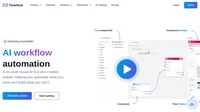What is ROAI?
ROAI measures the impact of AI investments on a company’s operations, productivity, and profitability. As businesses increasingly adopt AI-powered solutions to automate tasks, enhance customer experiences, and gain competitive advantages, assessing the ROAI becomes crucial to understanding whether these investments are delivering tangible benefits.
While ROI evaluates the overall profitability of any investment, ROAI zooms in on the returns generated from AI-specific initiatives. It takes into account the unique challenges and opportunities presented by AI technologies, including the intangible benefits that may not have immediate financial returns but contribute to long-term success.
How is ROAI Used?
ROAI is used by organizations to:
- Evaluate AI Investments: Determine whether AI projects are providing value commensurate with their costs.
- Strategic Decision-Making: Guide decisions about continuing, scaling, or discontinuing AI initiatives based on their performance.
- Benchmarking: Compare the effectiveness of different AI solutions or projects within or across organizations.
- Optimize Resources: Ensure that resources allocated to AI are yielding the desired outcomes, whether in cost savings, revenue generation, or efficiency improvements.
Measuring ROAI
Challenges in Measuring ROAI
Measuring the ROAI presents several challenges:
- Intangible Benefits: Many benefits of AI, such as improved customer satisfaction or enhanced decision-making capabilities, are difficult to quantify in monetary terms.
- Delayed Returns: AI investments may not yield immediate financial gains. Benefits often accumulate over time, making it harder to attribute them directly to the AI initiative.
- Complexity of Projects: AI projects can be complex and multifaceted, involving data quality issues, integration challenges, and the need for cultural or organizational changes.
- Lack of Clear KPIs: Without well-defined key performance indicators (KPIs), it becomes difficult to assess the success of AI initiatives accurately.
Strategies for Measuring ROAI
To effectively measure ROAI, organizations can:
1. Identify Specific Use Cases and Objectives
Before investing in AI, clearly define the problems you aim to solve and the objectives you wish to achieve. This could include automating routine tasks, reducing operational costs, increasing sales, or improving customer service.
2. Establish Measurable KPIs
Set specific, quantifiable metrics that align with your objectives. For example:
- Time Savings: Reduction in hours spent on manual tasks due to automation.
- Cost Reduction: Decrease in operational expenses as a result of AI efficiencies.
- Revenue Growth: Increase in sales attributed to AI-driven marketing or sales strategies.
- Error Reduction: Decrease in errors or defects due to AI-assisted processes.
3. Baseline Measurement
Establish a baseline to compare the performance before and after implementing the AI solution. This allows for a clear assessment of the impact.
4. Continuous Monitoring
Monitor the AI initiative over time to track progress against KPIs. Use analytics tools to gather data and adjust strategies as needed.
5. Consider Both Hard and Soft Returns
- Hard Returns: Direct financial benefits such as cost savings or revenue increases.
- Soft Returns: Indirect benefits like improved customer satisfaction, enhanced employee engagement, or better decision-making.
Examples and Use Cases of ROAI
Law Firms
Law firms are increasingly adopting AI technologies to improve efficiency and profitability. Examples include:
Automation of Routine Tasks
- Billing Review: AI-powered applications can automate billing reviews, saving countless hours that lawyers would otherwise spend manually.
- Document Analysis and Drafting: AI tools can analyze legal documents, identify key information, and even assist in drafting contracts or briefs.
Benefits
- Time Savings: Lawyers can focus on higher-value tasks, increasing billable hours.
- Cost Reduction: Reduced need for administrative staff or overtime expenses.
- Improved Accuracy: AI reduces the potential for human error, leading to more reliable outcomes.
Measuring ROAI in Law Firms
- Increased Billable Hours: Measure the additional revenue generated from lawyers spending more time on client work.
- Reduced Operational Costs: Calculate savings from decreased administrative expenses.
- Client Satisfaction: Assess improvements in client feedback due to faster turnaround times.
Healthcare
Healthcare organizations leverage AI for:
Medical Imaging and Diagnostics
- AI Algorithms: Analyze CT scans, MRIs, and X-rays to detect anomalies more quickly and accurately.
Benefits
- Improved Patient Outcomes: Early detection of diseases leads to better treatment success rates.
- Efficiency: Faster analysis reduces patient wait times.
Measuring ROAI in Healthcare
- Patient Throughput: Increase in the number of patients diagnosed and treated.
- Accuracy Rates: Reduction in misdiagnoses or false positives/negatives.
- Cost Savings: Decreased need for repeat tests due to improved accuracy.
Retail
Retailers use AI for:
Customer Service Automation
- Virtual Assistants and Chatbots: Provide 24/7 customer support, answering queries, and assisting with purchases.
Inventory Management
- Predictive Analytics: AI predicts demand, optimizing inventory levels to reduce overstocking or stockouts.
Benefits
- Enhanced Customer Experience: Quick and efficient service increases customer satisfaction and loyalty.
- Revenue Growth: Personalized recommendations can boost sales.
Measuring ROAI in Retail
- Sales Increase: Additional revenue from upselling or cross-selling via AI recommendations.
- Cost Reduction: Savings from optimized inventory management.
- Customer Retention Rates: Improvement in repeat customers due to better service.
Steps for Achieving ROAI
To maximize ROAI, organizations should take a strategic approach:
1. Identify Pain Points
- Assess Challenges: Gather feedback from staff to understand difficulties in daily tasks.
- Prioritize Needs: Focus on areas where AI can have the most significant impact.
2. Focus on Value-Driven Solutions
- Avoid the Shiny Object Syndrome: Don’t invest in technology for its own sake.
- Align with Business Goals: Ensure AI initiatives support the organization’s strategic objectives.
3. Use Search Engines for Research
- Targeted Searches: Look for AI solutions that address specific pain points.
- App Directories: Utilize directories to find and compare AI applications relevant to your industry.
4. Look for Specifics
- Detailed Functionality: Seek apps that clearly describe their features and benefits.
- Evidence of Effectiveness: Prefer solutions with demo videos or case studies demonstrating their impact.
- Transparent Pricing: Choose providers that display clear pricing information.
5. Require a Free Trial
- Hands-On Experience: Test the AI solution in your real-life environment.
- Assess Fit: Determine if the app meets your specific needs before committing.
6. Ease of Implementation
- Integration Capabilities: Ensure the AI solution integrates smoothly with existing systems.
- User Training: Verify that adequate training resources are available.
- Support Services: Evaluate the responsiveness and helpfulness of the provider’s support team.
7. Compare to Existing Practices
- Side-by-Side Testing: Measure performance using current methods versus the AI solution.
- Quantify Improvements: Calculate time saved, increased productivity, or error reduction.
Strategies to Optimize and Maximize AI Investments
To fully realize the potential of AI and achieve maximum ROAI:
Outcome-Based Approach
Adopt an outcome-based framework that focuses on:
- Business Objectives: Clearly define what the organization aims to achieve with AI.
- Use Cases and Capabilities: Identify specific AI applications that align with these objectives.
- Success Criteria: Establish KPIs and metrics to measure success.
Align Technology with Business Needs
- Holistic Strategy: Ensure that AI initiatives are part of a broader digital transformation strategy.
- Cross-Functional Collaboration: Encourage collaboration between IT and business units to align goals.
Continuous Evaluation and Adjustment
- Monitor Performance: Regularly assess AI projects against KPIs.
- Adjust Strategies: Be prepared to pivot or refine AI initiatives based on performance data.
Invest in Data Quality and Infrastructure
- High-Quality Data: Ensure that data feeding AI systems is accurate and relevant.
- Scalable Infrastructure: Invest in technology that can grow with the organization’s needs.
Build vs. Buy Decision
When considering AI solutions, organizations face the choice between building in-house or purchasing from a vendor.
Building In-House
- Pros:
- Customization: Tailored to specific needs.
- Control: Full oversight of development and data.
- Cons:
- Costly and Time-Consuming: Requires significant resources and expertise.
- Maintenance Burden: Ongoing updates and support demand continuous investment.
Purchasing from a Vendor
- Pros:
- Faster Implementation: Ready-to-use solutions accelerate deployment.
- Expert Support: Access to specialized knowledge and assistance.
- Cons:
- Less Customization: May need to adapt processes to the software.
- Dependency on Provider: Rely on vendor for updates and support.
Consider factors such as cost, time, expertise, resources, and strategic alignment when making this decision.
The Role of AI Copilots
An emerging concept in maximizing ROAI is the use of AI copilots.
What is an AI Copilot?
An AI copilot is a conversational interface that leverages large language models (LLMs) within an enterprise environment. It automates tasks and retrieves information across multiple domains, applications, and business systems.
Four-Tiered Framework for AI Copilots
Organizations can use a four-tiered framework to understand the technology and investments necessary to integrate LLMs into production environments:
Tier One: Simple LLM Integration
- Description: Basic integration utilizing standard API calls.
- Use Cases: Simple automation tasks or information retrieval.
Tier Two: Customized LLM Integration
- Description: Integration grounded in domain-specific data.
- Use Cases: Tailored solutions addressing specific organizational needs.
Tier Three: Chained LLMs
- Description: Multiple LLMs connected to create sophisticated pipelines.
- Use Cases: Complex, multi-step processes requiring advanced reasoning.
Tier Four: Enterprise-Grade AI Copilot
- Description: Advanced LLM system designed for enterprise-wide deployment.
- Features: Reasoning engine, analytics, connectors, security, and privacy.
Benefits of AI Copilots
- Operational Efficiency: Streamline processes and reduce manual workload.
- Enhanced Experiences: Improve interactions with customers and employees.
- Accelerated Transformation: Enable rapid adoption of AI across the organization.
Real-World Example: Law Firm Implementing an AI Solution
Scenario
A law firm struggles with time-consuming billing review processes, leading to decreased profitability and lawyer burnout.
Steps Taken
- Identify Pain Point: Recognized that manual billing review was inefficient and prone to errors.
- Research Solutions: Used search engines to find AI-powered billing review applications.
- Evaluate Options: Looked for apps with clear functionality descriptions, demo videos, and transparent pricing.
- Free Trial: Tested the app in their real environment to assess fit and effectiveness.
- Assess Implementation Ease: Ensured the app integrated with their existing billing system and that training resources were available.
- Side-by-Side Comparison: Compared the time and accuracy of billing reviews before and after implementing the AI solution.
Results
- Time Savings: Reduced billing review time by 50%.
- Cost Reduction: Lowered administrative expenses associated with billing.
- Increased Revenue: Lawyers devoted more time to billable work, increasing firm profitability.
- Improved Accuracy: Fewer billing errors led to better client satisfaction.
Measuring ROAI
- Return Calculation:
- Net Gain: Increased revenue + cost savings.
- Investment Cost: Price of the AI solution + implementation expenses.
- ROAI: (Net Gain / Investment Cost) × 100%
Research on Return on Artificial Intelligence (ROAI)
Return on Artificial Intelligence (ROAI) is a measure of the return on investment for AI-specific initiatives. As organizations increasingly adopt AI technologies, understanding and optimizing ROAI becomes crucial. Below are some significant research papers exploring various aspects of ROAI:
- Learning to Mix n-Step Returns: Generalizing lambda-Returns for Deep Reinforcement Learning
This paper, authored by Sahil Sharma et al., discusses the use of reinforcement learning (RL) to model complex behavior policies for decision-making tasks. It focuses on lambda-returns, which generalize beyond 1-step returns, and proposes Confidence-based Autodidactic Returns (CAR) to allow RL agents to learn the weighting of n-step returns. The study demonstrates the effectiveness of these sophisticated weighted mixtures in improving RL algorithms like the Asynchronous Advantage Actor Critic (A3C) in the Atari 2600 domain. Read more. - Predicting Abnormal Returns From News Using Text Classification
Ronny Luss and Alexandre d’Aspremont explore how news article text can predict intraday price movements using support vector machines. Their study integrates text with equity returns as predictive features, significantly enhancing classification performance over historical returns alone. This paper highlights the potential of textual data in forecasting financial asset returns. Read more. - Variance Penalized On-Policy and Off-Policy Actor-Critic
Authored by Arushi Jain et al., this paper presents reinforcement learning algorithms that optimize both mean and variance in the return, which is crucial for applications requiring reliable performance. The algorithms use a direct variance estimator, ensuring convergence to optimal policies in Markov decision processes, and are tested in both tabular and continuous domains. Read more. - Returning the Favor: What Wireless Networking Can Offer to AI and Edge Learning
This research, by Sameh Sorour et al., examines the intersection of wireless networking and AI, exploring how advancements in networking can enhance AI and edge learning. The paper discusses various applications and benefits of integrating these technologies, offering insights into improving ROAI by leveraging network capabilities. Read more.



